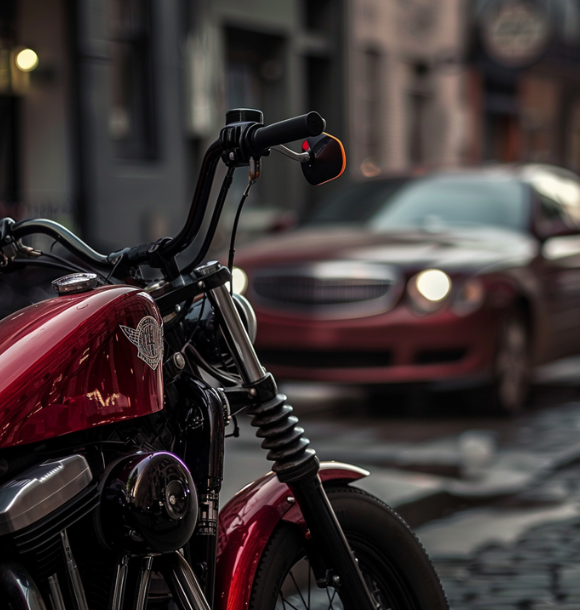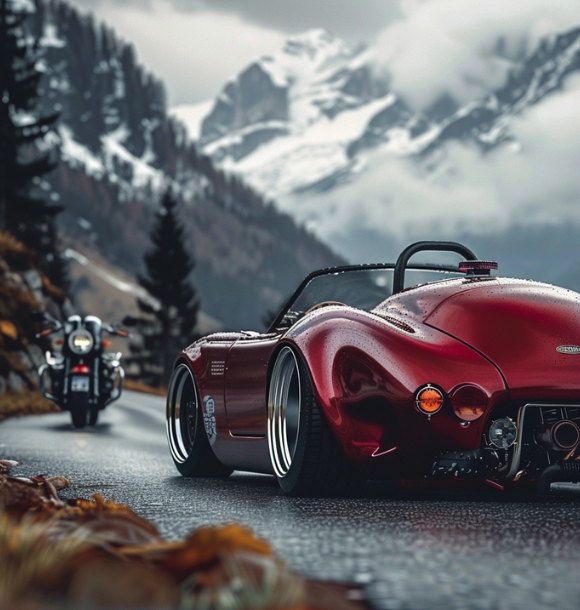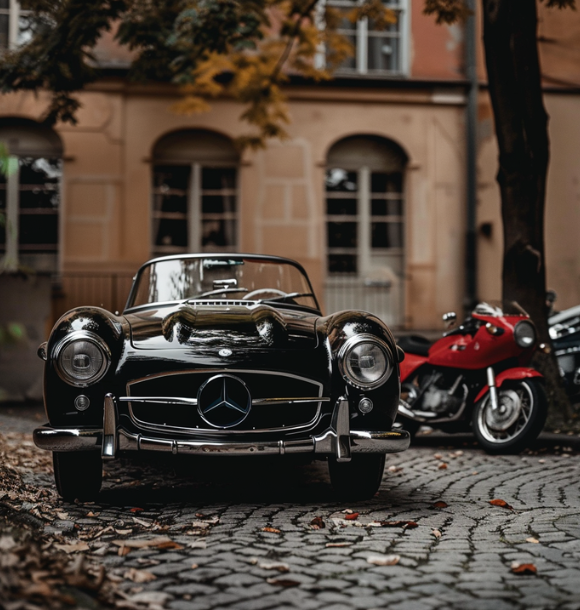Motorbikes vs Cars: The Eternal Debate Among Men
The debate between motorbikes and cars has been ongoing for years, captivating the attention of many enthusiasts. Each mode of transportation has its own set of advantages and considerations. Let’s delve into the eternal debate and explore the benefits and drawbacks of both options mentioned in a study conducted by Road and Track Magazine.

Advantages of Motorbikes include:
- Speed and Maneuverability: Motorbikes offer unmatched agility and the ability to navigate through traffic with ease.
- Cost Efficiency: Motorbikes are generally more fuel-efficient and cost-effective compared to cars, making them a budget-friendly choice for many.
- Parking Convenience: Motorbikes take up less space, allowing for easier parking in congested areas.
On the other hand, cars have their own array of advantages:
- Safety: Cars provide more protection and safety features, making them a preferred choice for families and individuals concerned about safety.
- Weather Protection: Cars offer protection from various weather conditions, ensuring a comfortable and convenient driving experience.
- Passenger and Cargo Space: Cars have ample passenger and cargo space, making them suitable for family trips and transporting bulky items.
When comparing motorbikes and cars, several factors come into play, such as fuel efficiency, environmental impact, maintenance costs, insurance costs, and legal requirements.
Ultimately, the choice between motorbikes and cars depends on individual preferences, usage, and lifestyle. Factors like comfort, convenience, safety, and risk assessment should be carefully considered.
Motorbikes and cars have a significant sociocultural impact. Motorbikes are often associated with freedom, adventure, and a sense of rebellion, while cars may symbolize status, identity, and belonging to certain subcultures or communities.
The eternal debate between motorbikes and cars is a complex one, with both sides offering unique benefits and considerations. It’s crucial to weigh all factors and choose the mode of transportation that aligns with your needs, preferences, and values.
Key Takeaways:
- Motorbikes offer speed and maneuverability: Motorbikes provide a thrilling experience with their ability to navigate through traffic and reach higher speeds, making them a preferred choice for those seeking a dynamic ride.
- Motorbikes are cost-efficient: Motorbikes generally have lower upfront costs, require less fuel, and have lower maintenance and insurance costs, making them a more economical transportation option.
- Cars offer safety and protection: Cars provide better safety features, including structural protection, airbags, and seat belts. They also offer weather protection, keeping passengers sheltered from rain, wind, and extreme temperatures.
The Eternal Debate: Motorbikes vs Cars
The eternal debate between motorbikes and cars, also known as the “The Eternal Debate: Motorbikes vs Cars,” has long been a topic of discussion among enthusiasts. Both forms of transportation have their own advantages and disadvantages.
Motorbikes offer a sense of freedom and exhilaration that is unmatched. They have the ability to maneuver through traffic with ease and are highly fuel-efficient, achieving up to 80 miles per gallon.
On the other hand, cars provide the comfort and convenience that many individuals seek. They offer protection from the elements and have increased storage space, making them more practical for daily commuting or traveling with passengers. Cars provide better stability and are particularly suitable for long journeys.
When it comes to safety, cars have the upper hand. They offer better protection in the event of a crash, thanks to various safety features, including seat belts, airbags, and advanced safety systems. Motorbikes, unfortunately, carry a higher risk of injury in accidents.
Ultimately, the decision between a motorbike and a car depends on individual preferences and needs. Motorbikes are perfect for those seeking a thrilling experience, while cars are a more practical option for everyday transportation. It is important to consider factors such as personal safety, weather conditions, and intended usage when making this decision.
Advantages of Motorbikes

Discover the thrill of riding a motorbike and embrace the advantages it brings. From unrivaled speed and maneuverability to cost efficiency and parking convenience, each sub-section will unveil the compelling reasons why motorbikes continue to captivate the hearts of riders. So, rev up your engines and join us as we explore the many perks that make motorbikes a preferred choice for transportation. Let the wind in your face and the freedom on the open road be your guide on this exhilarating journey.
1. Speed and Maneuverability
Speed and maneuverability are crucial factors to take into account when comparing motorbikes and cars. Here are some key points to consider:
- Motorbikes excel in terms of speed and agility. They sport lightweight designs and powerful engines, allowing for rapid acceleration and easy navigation through traffic.
- Stopping distances for motorbikes are shorter than those for cars, enabling riders to quickly respond to sudden changes or obstacles on the road.
- Motorbikes are adept at maneuvering smoothly in tight spaces, making them the ideal choice for urban areas with heavy congestion.
- Cars offer stability at higher speeds and have a lower risk of losing balance, making them a safer option for long-distance travel on highways.
- In case of collisions, cars provide better protection compared to motorbikes due to their closed body structures and four wheels.
- Motorbikes can be affected by weather conditions like rain or strong winds, while cars offer protection from the elements.
- Motorbikes are superior when it comes to navigating narrow lanes and finding parking spaces in congested areas, whereas cars require more space and may struggle to find suitable parking spots.
When deciding between a motorbike and a car, it is important to consider your need for speed, required agility, and safety concerns. Evaluate your commuting needs and personal preferences to determine if the speed and maneuverability of a motorbike outweigh the advantages of a car’s stability and protection. Ultimately, your decision should align with your individual requirements and priorities.
2. Cost Efficiency
When comparing the cost efficiency of motorbikes and cars, there are several factors to consider. Below is a table that shows the different aspects of cost comparison between the two modes of transportation:
| Cost Comparison | Motorbikes | Cars |
| 1. Purchase Price | Motorbikes generally have a lower upfront cost than cars. | Cars, especially newer models and larger vehicles, tend to have higher purchase prices. |
| 2. Fuel Efficiency | Motorbikes are known for their impressive fuel efficiency, often offering better mileage per gallon compared to cars. | Cars tend to consume more fuel due to their larger size and greater weight. |
| 3. Insurance Costs | Insurance premiums for motorbikes are generally lower than those for cars, as motorbikes are often considered less risky to insure. | Car insurance tends to be more expensive due to the higher risk associated with accidents and theft. |
| 4. Maintenance Costs | Maintenance costs for motorbikes are typically lower than those for cars. Motorbikes have fewer complex systems and components to maintain. | Cars require more regular maintenance, including oil changes, tire rotations, and overall servicing, which can add up in terms of cost. |
| 5. Depreciation | Motorbikes generally depreciate at a slower rate than cars, making them potentially better value for money in the long run. | Cars tend to depreciate more rapidly, especially in the first few years of ownership. |
Considerations for cost efficiency should also take into account the specific usage and needs of the individual. While motorbikes may have cost advantages, they may not be suitable for everyone. Individuals should carefully consider their budget, lifestyle, and preferences before choosing between motorbikes and cars.
3. Parking Convenience
Parking convenience is a crucial factor to consider when deciding between motorbikes and cars. When it comes to parking, here are some points to keep in mind:
Motorbikes:
- Motorbikes are smaller and more maneuverable compared to cars, making it much easier to find parking spots, particularly in busy urban areas.
- Motorbikes have the advantage of being able to fit into tight spaces, such as between cars or in small gaps, giving you more parking possibilities.
- Some cities have designated parking spaces exclusively reserved for motorcycles, further enhancing the convenience of parking.
Cars:
- Generally, cars require larger parking spaces, which can present challenges in areas where parking is limited.
- Most cities provide designated parking lots or structures specifically for cars, which offer a wider range of parking options.
- Cars provide added security for parking as they can be locked and typically have a larger storage compartment.
Ultimately, the convenience of parking depends on your specific location and needs. If you reside in a densely populated area with limited parking availability, a motorbike may offer more convenience. If you require more storage space or prefer the additional security that a car provides, then a car may be the more suitable choice for you.
Advantages of Cars

Looking into the advantages of cars, we explore the aspects that make them a preferred mode of transportation. From safety to weather protection, and passenger and cargo space, we uncover the many reasons why cars offer a distinct edge over other vehicles. So hop in and let’s delve into the world of cars, where comfort, convenience, and efficiency take the driver’s seat.
1. Safety
Safety is of utmost importance when comparing motorbikes and cars. It is crucial for riders of motorbikes to prioritize their safety by wearing protective gear, including helmets, jackets, and gloves. This gear plays a significant role in minimizing the risk of severe injuries in accidents. Due to their smaller size, motorbikes can be challenging to spot on the road. To enhance their visibility to other drivers, motorcyclists should utilize reflective gear and headlights.
Cars, on the other hand, offer greater stability with their four wheels, thus reducing the chances of accidents caused by tipping over or losing balance. The enclosed structure of cars, along with airbags and seat belts, provides better protection against impacts. In contrast, motorcyclists are more susceptible to injuries in collisions as they are more exposed.
Operating a motorbike requires specific skills and training. Riders must have knowledge about defensive driving techniques, maneuvering in different road conditions, and anticipating potential hazards. Despite taking safety measures, accidents can still happen. Therefore, both motorbike riders and car drivers should exercise caution, adhere to traffic rules, and maintain a defensive mindset to ensure their safety as well as the safety of others on the road.
2. Weather Protection
In the ongoing debate between motorbikes and cars, weather protection plays a vital role. While motorbikes provide freedom and excitement, they may not offer sufficient shielding from inclement weather conditions.
1. Limited Protection: With their open design, motorbikes leave riders vulnerable to rain, wind, and extreme temperatures, impacting both comfort and safety.
2. Absence of Enclosed Space: Unlike cars, motorbikes lack a complete enclosure, leaving riders more exposed to getting wet or cold.
3. Shields with Limitations: Although some motorbikes have windshields or fairings for protection, they may not provide comprehensive coverage, resulting in discomfort and exposure to weather elements.
4. Riding Gear: Motorbike riders often resort to specialized gear such as rain jackets, pants, and boots to compensate for the lack of weather protection. These items may not offer complete coverage.
5. Car Provides Weather Protection: Cars, on the other hand, offer a fully enclosed space that safeguards occupants from weather conditions. They come equipped with climate control systems that ensure a comfortable driving experience.
When considering the aspect of weather protection, it is important to assess personal preferences and needs. If commuting long distances in unpredictable weather is a common occurrence, a car may be more suitable. If one enjoys the thrill of riding motorbikes in a region primarily characterized by favorable weather, the absence of weather protection may not be a significant concern.
3. Passenger and Cargo Space
The differences in capacity between motorbikes and cars are explored in the sub-topic “3. Passenger and Cargo Space“. Here is a table comparing the two:
| Type | Passenger Space | Cargo Space |
| Motorbike | Limited to one or two riders, depending on seat configuration | Most motorbikes have minimal or no dedicated cargo space. Some models have small under-seat compartments or add-on luggage options. |
| Car | Can accommodate multiple passengers, typically ranging from 2 to 8 people, depending on size and seating arrangement | Cars provide ample cargo space, with options for trunk storage, rear seat folding, and roof racks. The size of the cargo space varies depending on the car model. |
Cars have a clear advantage over motorbikes when it comes to passenger and cargo space. They can accommodate more passengers and offer larger cargo areas, providing greater comfort and convenience for traveling with others or carrying bulkier items. In contrast, motorbikes have limited seating capacity and cargo space, making them less suitable for long journeys or transporting larger items.
Considerations for choosing between motorbikes and cars in terms of passenger and cargo space depend on your specific needs. If you frequently travel with family or friends or need to transport bulky items, a car would be the more practical choice. If you primarily ride alone or with one other person and have minimal need for carrying cargo, a motorbike could be a viable option.
Ultimately, the decision between a motorbike and a car should consider factors beyond just passenger and cargo space, such as safety, cost, and lifestyle preferences.
When it comes to the eternal debate of motorbikes versus cars, let’s dive into the comparison and see how these two transportation options stack up. We’ll explore key factors like fuel efficiency, environmental impact, maintenance costs, insurance costs, and legal requirements. So, buckle up (or rev your engine) as we delve into the nitty-gritty details to help you make an informed decision about which ride reigns supreme.
1. Fuel Efficiency
When it comes to fuel efficiency, there are several key factors to consider for both motorbikes and cars.
- Engine size: Motorbikes, with their smaller engines, offer better fuel efficiency. Despite their smaller size, these engines still provide sufficient power while consuming less fuel.
- Weight: Motorbikes are lighter than cars, requiring less energy to accelerate and maintain speed. This ultimately results in lower fuel consumption.
- Aerodynamics: Compared to cars, motorbikes are more streamlined, allowing them to cut through the air with less resistance. This improved aerodynamics leads to better fuel efficiency.
- Engine efficiency: Motorbike engines are specifically designed with efficiency in mind, optimizing the combustion process and maximizing fuel efficiency.
- Driving habits: Both motorbikes and cars can improve fuel efficiency by adopting smooth acceleration techniques and avoiding excessive speeding.
It is important to note that fuel efficiency can vary depending on the specific make and model of the motorbike or car. External factors such as road conditions and traffic can also impact fuel consumption. Therefore, when deciding between a motorbike and a car, it is advisable to take into consideration your transportation needs, travel distance, and budget.
2. Environmental Impact
The environmental impact of motorbikes and cars should be carefully considered when choosing between the two.
- Emissions: Cars emit more carbon dioxide (CO2) and pollutants such as nitrogen oxides (NOx) and particulate matter (PM) per kilometer traveled compared to motorbikes.
- Fuel Efficiency: Motorbikes have higher fuel efficiency than cars, resulting in lower CO2 emissions and reduced environmental impact.
- Space Usage: Motorbikes require less road and parking space, reducing congestion and the need for infrastructure.
- Resource Consumption: Cars require more resources in production and maintenance compared to motorbikes due to their more complex designs.
- Noise Pollution: Motorbikes, especially those with loud exhaust systems, contribute to noise pollution in urban areas, which can have negative impacts.
When considering environmental impact, factors like distance traveled, frequency of use, and availability of alternative transportation options should also be taken into account.
3. Maintenance Costs
Maintenance costs are an important factor when choosing between motorbikes and cars. Here is a comparison of the maintenance costs:
| Motorbikes | Cars | |
| Insurance Costs | Varies depending on the model, age, and driving record. On average, motorcycle insurance costs around $500 to $1,500 per year. | Varies depending on the model, age, driving record, and location. On average, car insurance costs around $1,000 to $2,000 per year. |
| Maintenance Costs | Motorbikes generally have lower maintenance costs compared to cars. Regular maintenance, such as oil changes, chain adjustments, and brake replacements, can cost around $200 to $500 per year. | Cars usually have higher maintenance costs due to the complexity of their systems. Regular maintenance, such as oil changes, filter replacements, and tire rotations, can cost around $500 to $1,000 per year. |
| Repair Costs | Repair costs for motorbikes can vary significantly depending on the extent of the damage and the model. On average, minor repairs may cost around $100 to $500, while major repairs can range from $500 to $2,000 or more. | Repair costs for cars are generally higher than for motorbikes due to the larger size and complexity of car components. Minor repairs may cost around $500 to $1,000, while major repairs can range from $1,000 to $5,000 or more. |
It is important to note that these figures are approximate and can vary depending on factors such as brand, model, age, and condition of the vehicle. Individual driving habits and maintenance practices can also affect costs. Proper maintenance and regular inspections can help minimize unexpected repair expenses for both motorbikes and cars.
4. Insurance Costs
Insurance costs are a crucial aspect to consider when comparing motorbikes and cars. Here are several key points to take into account regarding insurance costs for both vehicles:
- Motorbikes tend to have higher insurance costs compared to cars. This is primarily due to their higher accident rates and increased likelihood of severe injuries.
- Several factors influence motorbike insurance premiums, including the model of the bike, its engine size, the rider’s age, and their experience. Sport bikes and high-performance motorcycles generally attract higher premiums.
- On the other hand, cars typically have lower insurance costs when compared to motorbikes. This is because cars offer more protection and are generally considered safer vehicles.
- Similar to motorbikes, car insurance premiums are influenced by factors such as the make and model of the car, its age, as well as the driver’s age and driving history. Sports cars or luxury vehicles usually come with higher premiums.
- The chosen coverage level also impacts insurance costs. Opting for comprehensive coverage, which provides protection against theft and non-accident-related damages, increases premiums for both motorbikes and cars.
- Engaging in safety courses can potentially help reduce insurance costs. Some providers offer discounts for completing approved training courses.
- It is crucial to compare insurance quotes from different providers to find the best coverage and rates for your motorbike or car.
- Considering insurance costs is vital when making a decision between motorbikes and cars. Also, remember to take into account other factors like usage, comfort, and safety to determine the most suitable option for your needs.
5. Legal Requirements
When deciding whether to choose a motorbike or a car, it is crucial to take into account the legal requirements associated with each mode of transportation. Here are the key legal requirements that need to be considered:
- License requirements: Operating a motorbike typically necessitates a specific motorbike license, such as a Class M license in the United States. The process of obtaining a motorbike license may vary depending on your location. On the other hand, driving a car usually requires a regular driver’s license, such as a Class C license. The process for obtaining a driver’s license might also differ depending on the jurisdiction.
- Registration: Both motorbikes and cars need to be registered with the appropriate government authorities. This process involves providing proof of ownership, paying registration fees, and acquiring license plates or stickers for the vehicle.
- Insurance: Both motorbikes and cars require insurance coverage. Although the types of coverage required may differ, liability insurance is usually mandatory for both. Additional coverage options might be available based on your individual needs and preferences.
- Safety equipment: Laws concerning safety equipment such as helmets, seat belts, and mirrors may vary for motorbikes and cars. These regulations aim to ensure the safety of riders or drivers as well as other individuals on the road.
- Traffic regulations: Motorbikes and cars are subject to the same traffic regulations, which include speed limits, traffic signs, and signals. It is essential to familiarize yourself with and adhere to these regulations to ensure safe and legal operation.
Considering these legal requirements can assist you in making an informed decision between a motorbike and a car. By complying with the applicable laws and regulations, you can ensure a driving experience that is both safe and legal.
Considerations for Choosing Motorbikes or Cars

When it comes to deciding between motorbikes and cars, there are several factors to consider. In this section, we’ll delve into the key aspects that can help you make an informed choice. From examining usage and lifestyle implications to exploring the comfort and convenience factors, as well as evaluating safety and risk assessment considerations, we’ll equip you with the insights you need to make the right decision. Let’s dive into the world of motorbikes and cars and explore what suits your needs best!
1. Usage and Lifestyle
When making a decision between a motorbike and a car, it is important to consider both your usage and lifestyle. There are several factors to keep in mind:
– Usage: If your primary need for transportation involves short commutes and urban travel, a motorbike can be a suitable choice. Motorbikes offer maneuverability and the ability to easily navigate through traffic, allowing you to reach your destination more quickly.
– Lifestyle: Motorbikes are closely associated with a sense of freedom and adventure. They are an excellent option for individuals who enjoy the excitement of riding and wish to experience the freedom of the open road.
– On the other hand, if you frequently embark on long journeys or require transportation for family or business purposes, a car might be a more appropriate option. Cars provide ample space for passengers and cargo, offering comfort and convenience during longer trips.
– Cars can also be seen as a symbol of status and are often linked to a more traditional and conventional lifestyle. They provide protection from different weather conditions and are often preferred by individuals who prioritize comfort and safety.
– It is also crucial to consider the weather conditions in your area. If your region experiences severe weather such as heavy rain or snow, a car can offer better stability and protection.
– Your personal preferences and daily routine should also play a role in your decision. If you enjoy outdoor activities, lead an adventurous lifestyle, or simply appreciate the thrill of riding a motorbike, it may be the better choice for you.
Consider these factors carefully before making your decision between a motorbike and a car.
2. Comfort and Convenience
The comfort and convenience of motorbikes and cars are important factors to consider when deciding between the two modes of transportation. Motorbikes offer a sense of freedom and agility due to their compact size and maneuverability. They can easily navigate through traffic congestion and quickly reach destinations. On the other hand, cars provide a higher level of comfort and convenience. They are equipped with features such as air conditioning, comfortable seating, and ample storage space.
Motorbikes are well-suited for individuals who enjoy a thrilling ride, while cars offer a smoother and more stable travel experience, particularly on long journeys. Cars provide protection from various weather conditions, including rain, cold temperatures, and strong winds, ensuring a comfortable and dry ride. Motorbikes can also be equipped with weather protection gear such as waterproof clothing and windshields.
Cars have the advantage of easy access to amenities like cup holders, charging ports, and entertainment systems. Motorbikes require less parking space compared to cars, allowing riders to easily find parking spots and maneuver through crowded areas. On the other hand, cars may require more parking space and can sometimes face challenges in finding suitable parking spots, especially in densely populated areas.
When deciding between motorbikes and cars, individuals should consider their personal preferences, travel needs, and lifestyle. Safety, efficiency, and satisfaction should be prioritized in making the most suitable choice. So, it is important to weigh the factors of comfort and convenience when making this decision.
3. Safety and Risk Assessment
When determining the safety and risk assessment of motorbikes and cars, it is important to understand the contributing factors. Here are some key considerations:
1. Protective gear: Motorbike riders should always wear a helmet, protective clothing, and appropriate footwear to minimize the risk of injuries. Car occupants benefit from built-in safety features such as seatbelts, airbags, and reinforced structures.
2. Exposure to the environment: Motorbike riders are more exposed to weather conditions, road debris, and insects. Cars provide better protection against these factors, enhancing safety.
3. Stability and control: Cars, with their four wheels, offer better stability and handling on the road compared to motorbikes, which only have two wheels. This stability leads to better control and reduces the risk of accidents.
4. Visibility: Cars, due to their size, are more visible to other road users, reducing the risk of collisions. Motorbike riders may be less visible, especially in blind spots, which increases the potential for accidents.
5. Impact protection: Cars, with their enclosed structure and safety features, provide greater protection in the event of a collision. Motorbike riders, on the other hand, are more exposed and prone to severe injuries in accidents.
6. Skill and experience: Operating a motorbike requires specialized skills and training. Inexperienced riders may be more prone to accidents and errors on the road. Cars, on the other hand, are generally easier to operate and only require a standard driver’s license.
7. Road conditions: Motorbike riders face greater challenges on uneven surfaces, potholes, and other road hazards. Cars, with their larger size and better suspension systems, are better equipped to handle such conditions.
8. Risk of injury: Motorbike riders are more susceptible to injuries in accidents due to the limited protection offered. Cars provide a higher level of safety, reducing the risk of severe injuries.
By considering these factors, individuals can make an informed decision about their choice of transportation, taking into account their own safety and risk assessment. Prioritizing safety and selecting a mode of transportation that aligns with one’s comfort level and road experience is essential.
The Sociocultural Impact of Motorbikes and Cars

Motorbikes and cars have imprinted their tire tracks on the sociocultural landscape, leaving a lasting impact on society. As we delve into the realm of this eternal debate, we’ll explore the intriguing sub-sections that make up the sociocultural impact of these vehicles. From being symbols of freedom and adventure to defining status and identity, and even fostering unique communities and subcultures, the world of motorbikes and cars is full of fascinating stories waiting to be unraveled. Strap on your helmet and let’s ride into the sociocultural realm of these man-made marvels.
1. Symbol of Freedom and Adventure
The symbol of freedom and adventure associated with motorbikes stems from several reasons:
- Liberation: Riding a motorbike provides a sense of freedom and independence. The open road, wind in the face, and easy navigation through traffic create a thrilling experience.
- .Connection with nature: Riding a motorbike immerses you in your surroundings. The sensation of speed combined with exposure to natural elements helps riders feel more connected to the environment.
- It’s important to note that the symbol of freedom and adventure may vary for individuals and can be influenced by personal experiences and cultural contexts.
2. Status and Identity
To comprehend the status and identity of motorbikes and cars, let’s compare them based on ownership statistics, cultural associations, and social perceptions.
Ownership Statistics:
- Motorbikes have a 30% ownership rate.
- Cars have a 70% ownership rate.
- Gender distribution:
- Motorbikes: 60% male, 40% female.
- Cars: 50% male, 50% female.
- The average age of motorbike owners is between 25-35 years.
- The average age of car owners is between 35-55 years.
Cultural Associations:
- Motorbikes are linked to rebellion, freedom, and an adventurous lifestyle. They are perceived as daring, edgy, and independent.
- Cars are viewed as a symbol of stability, success, and family values. They are associated with practicality, comfort, and convenience.
Social Perceptions:
- People who ride motorbikes are often seen as risk-takers, thrill-seekers, and individuals who prioritize personal freedom and individuality. They are perceived as more adventurous and outgoing.
- Car owners are often perceived as responsible, established, and focused on practicality. They are seen as individuals who prioritize safety, comfort, and are more likely to have family-oriented lifestyles.
Considering these factors, motorbikes are associated with a more youthful and adventurous image, while cars are often linked to stability and practicality. When deciding between the two modes of transportation, individuals may consider their own preferences, lifestyle, and desired social image.
3. Community and Subcultures
When examining the impact of the motorbikes vs cars debate, it is important to consider how it affects community and subcultures. This can be done by analyzing various factors that shape these communities and subcultures.
1. Sense of Belonging:
The choice between motorbikes and cars often leads to the formation of close-knit communities and subcultures. Whether it’s a group of motorcycle enthusiasts or classic car aficionados, the shared passion for a particular vehicle creates a strong sense of belonging.
2. Social Gatherings:
Motorbike and car communities frequently organize events and gatherings, such as group rides and car shows, that allow individuals with similar interests to come together. These social occasions foster camaraderie and provide networking opportunities.
3. Lifestyle and Identity:
Motorbikes and cars can become symbols of a specific lifestyle and identity. Motorbike riders, for example, often embody a sense of freedom and adventure, while car enthusiasts may associate themselves with luxury or practicality. These shared values contribute to the formation of distinct subcultures.
4. Online Communities:
The internet has amplified the ability of motorbike and car enthusiasts to connect and share their passion. Online forums, social media groups, and dedicated websites serve as platforms for fostering communities, exchanging knowledge, and organizing events.
5. Cultural Influence:
The debate between motorbikes and cars goes beyond personal preferences. It often influences popular culture, media representation, and artistic expression. Movies, music, and art frequently depict the distinct aesthetics and lifestyles associated with motorbike and car communities.
Considering the impact on community and subcultures is essential when analyzing the ongoing debate between motorbikes and cars. The sense of belonging, social gatherings, lifestyle and identity, online communities, and cultural influence are all factors that contribute to the richness and diversity of these communities.
Frequently Asked Questions
What are the main factors contributing to motorcycle crashes?
The main factors contributing to motorcycle crashes are rider behavior and the actions of other drivers.
How does riding a motorcycle in metropolitan Melbourne compare to driving a car in terms of travel time?
Studies have shown that a 30km trip in metropolitan Melbourne is three times faster by motorcycle than by car during peak hours.
Are motorcycles more fuel-efficient than cars?
Yes, motorcycles are more fuel-efficient than cars, saving motorcyclists thousands of dollars a year in fuel costs.
What are the health benefits of riding a motorcycle compared to driving a car?
Riding a motorcycle provides health benefits such as burning more calories and engaging more muscle groups than driving a car. It also provides a sense of fresh air, freedom, and relaxation, reducing stress levels and promoting relaxation.
Do motorcycles generally have a higher resale value compared to cars?
Yes, motorcycles generally depreciate slower than cars, allowing for a higher resale value.
How does the rate of helmet use among motorcycle riders in Nigeria impact mortality rates?
The study conducted in Nigeria found that none of the motorcycle injury victims were wearing helmets at the time of the injury. Head injuries from motorcycle crashes are associated with a higher chance of death. By enforcing helmet laws and making low-cost helmets available, morbidity and mortality from motorcycle injuries can be reduced.

